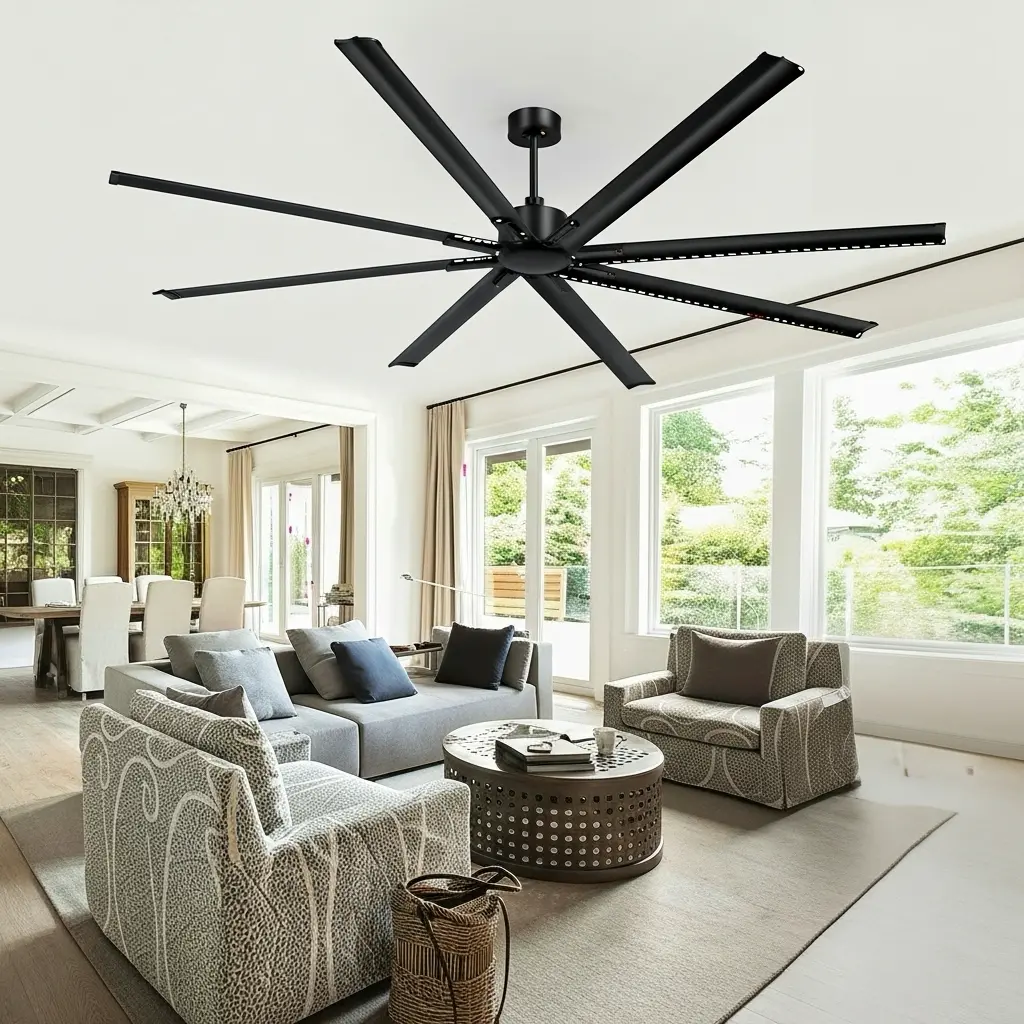A definitive U.S. guide to large industrial ceiling fans how they work, how to size them, brand comparisons, ROI math, U.S. standards (UL, OSHA, ASHRAE), and best practices for warehouses, factories, gyms, and barns.
Large industrial ceiling fans often called HVLS (High Volume, Low Speed) fans deliver massive, low-turbulence airflow that transforms thermal comfort, energy efficiency, and indoor air quality in large U.S. facilities. This guide is written for facility managers, engineers, architects, and contractors who want a rigorous, practical playbook covering physics, sizing, installation, codes, lifecycle costs, and brand comparisons, with U.S. case studies from Texas, Florida, Ohio, and California.
Table of Contents
1) What Counts as a “Large” Industrial Ceiling Fan?
Industrial fans with diameters ≥ 7 ft (2.1 m)—commonly 12–24 ft and up to 30 ft—qualify as “large.” They rotate slowly (≈ 40–70 RPM) to move exceptionally high air volume (hundreds of thousands of CFM) without the noise and turbulence of small, fast fans. Benefits include:
- Even air distribution (destratification): reduces hot/cold zones, improves HVAC effectiveness.
- Comfort via gentle air movement (2–3 ft/s perceived breeze) with minimal noise.
- Energy savings: typically 20–30% HVAC savings in cooling season; 15–25% in heating season through destratification.
- Coverage: one 24-ft fan can serve ~20,000–25,000 sq ft depending on ceiling height and layout.
Figure 1 – Image Placeholder: “large-industrial-fan-air-column.jpg” — a cutaway diagram showing the downward column and horizontal floor-jet spread pattern.
2) The Science: CFM, Tip Speed, Torque & Blade Pitch
Airflow performance is a function of diameter D, rotational speed N, blade geometry, and motor torque. A simplified relationship is:
CFM ≈ k × D² × N (k depends on blade design, air density, and losses)
Key engineering levers:
- Blade Diameter (D): Increasing D grows swept area (~D²), enabling huge volume at low RPM.
- Tip Speed: Too high raises drag and noise; optimal industrial ranges ≈ 700–1,200 ft/min for quiet, efficient operation.
- Blade Pitch (10–14° typical): Enables pressure differential for lift and forward thrust (floor-jet formation).
- Torque & Motor Type: Direct-drive PMSM/EC motors deliver high torque at low RPM with minimal maintenance.
Figure 2 – Chart Placeholder: “rpm-vs-noise-db.png” — line chart showing noise rising nonlinearly above optimal tip-speed band.
3) U.S. Use Cases & Sizing Heuristics (Texas, Florida, Ohio, California)
| Facility Type (State) | Typical Size & Height | Fan Diameter & Count | Target Air Speed | Notes |
|---|---|---|---|---|
| Texas Warehouse (DFW) | 80,000 sq ft, 28 ft ceiling | 3 × 24 ft | 2–3 ft/s in aisles | Aggressive cooling season; integrate with A/C to raise setpoint +3–4°F. |
| Florida Gym | 18,000 sq ft, 24 ft ceiling | 1 × 20 ft | ~2 ft/s over courts | Humidity control; prevents stagnant zones, improves perceived temp by ~6°F. |
| Ohio Manufacturing | 50,000 sq ft, 26 ft ceiling | 2 × 22 ft | 2–3 ft/s across lines | Disperse process heat; fan spacing 70–90 ft; avoid cranes/ducts. |
| California Barn (Central Valley) | 25,000 sq ft, 22 ft ceiling | 1 × 18–20 ft | Gentle: 1.5–2 ft/s | Livestock comfort; lower stress & humidity; corrosion-resistant finishes. |
Figure 3 – Image Placeholder: “coverage-map-overlap.png” — top view showing 60–120 ft spacing, overlap in high-density zones.
4) Brand Comparison (Performance, Efficiency, Noise)
Specs vary by series and options; the table below shows typical representative values for 18–24 ft models.
| Brand / Series | Diameter (ft) | Airflow (CFM) | Power (kW) | CFM/W | Noise (dB) | Motor |
|---|---|---|---|---|---|---|
| Big Ass Fans – Powerfoil | 24 | ~380k–400k | ~0.78 | ~490–515 | ~52 | Direct-drive PMSM |
| MacroAir – AirVolution D | 20 | ~300k–310k | ~0.65 | ~460–480 | ~50 | Direct-drive |
| Hunter Industrial – Titan | 24 | ~360k–380k | ~0.72 | ~500–530 | ~53 | EC / direct-drive |
| Marut Air – Elite | 18 | ~200k–220k | ~0.50 | ~400–440 | ~54 | EC |
Figure 4 – Chart Placeholder: “efficiency-cfm-per-watt-bars.png” — bar chart comparing CFM/W across the four series.
5) Placement & Installation: Engineering Best Practices (U.S.)
- Structure: Verify beam capacity; use rated clamps and a 1.5× safety factor for dynamic loads.
- Clearances: ≥ 2–3 ft above the fan; ≥ 10 ft from floor to blade tip; avoid sprinkler heads and low lighting.
- Spacing: 60–120 ft fan-to-fan depending on diameter, obstacles, and target floor velocity.
- Electrical: Dedicated 15–20 A circuit; comply with UL 507 and NEC; install safety cables.
- Commissioning: Level hub, verify torque, set control profiles (seasonal destratification/cooling modes).
Figure 5 – Image Placeholder: “mounting-and-safety-cables.jpg” — annotated photo showing proper beam clamps, safety guy wires, and clearance zones.
6) Controls & Integration (BMS, Sensors, Scheduling)
- Temperature sensors: Auto-adjust fan speed to maintain setpoint spread between floor and ceiling.
- Humidity input: In humid states (FL, LA), modulate speed to suppress condensation and odors.
- BMS: BACnet/Modbus integration for schedules, overrides, alarms, and demand response events.
7) U.S. Codes, Standards & Certifications
- UL 507 (Fans & Ventilators) — electrical safety.
- OSHA 29 CFR 1910 — electrical and walking-working surface safety; clearances, guards.
- ASHRAE 55 & 90.1 — thermal comfort & energy efficiency; HVLS recognized for energy conservation.
- NFPA 13 — coordinate with sprinklers; maintain required vertical/horizontal clearances.
- LEED v4.1 — EA credits for reduced HVAC energy, improved ventilation effectiveness.
8) Lifecycle Cost & ROI (United States)
Example assumptions: $0.14/kWh average U.S. commercial rate, 10 hrs/day, 260 days/year.
| Scenario | Fans / Size | Capex (Installed) | Annual Energy | HVAC Savings | Simple Payback |
|---|---|---|---|---|---|
| Texas 60k-sq-ft warehouse | 2 × 24 ft | $9,000–$12,000 | $420–$520/yr | $1,800–$2,500/yr | ~4.0–5.0 yrs |
| Ohio 40k-sq-ft factory | 2 × 22 ft | $8,000–$10,500 | $350–$430/yr | $1,400–$2,000/yr | ~3.5–5.5 yrs |
| Florida 20k-sq-ft gym | 1 × 20 ft | $4,500–$6,500 | $180–$240/yr | $700–$1,100/yr | ~3.8–6.0 yrs |
Figure 6 – Chart Placeholder: “payback-curve-60-months.png” — cumulative savings vs investment over 5 years for TX, OH, FL scenarios.
Tip: Many U.S. utilities offer custom rebates for verified HVAC kWh reductions. Pair HVLS with smart controls and provide a pre/post energy study to qualify.
9) Materials & Manufacturing: Blades, Hubs, Coatings
- Blades: Extruded aluminum is standard (light, corrosion-resistant). Advanced composites improve stiffness/weight ratios for premium lines.
- Hubs: Machined steel/aluminum with high-grade bearings; precision balancing to ISO standards reduces vibration.
- Coatings: Powder-coat (interior), epoxy or marine-grade for corrosive environments (coastal FL, CA dairies, food plants).
Figure 7 – Image Placeholder: “blade-profile-twist.jpg” — airfoil twist diagram showing variable pitch from hub to tip for uniform velocity profile.
10) Maintenance & Reliability
Direct-drive designs are largely maintenance-free. Establish a simple PM routine:
| Task | Interval | Why |
|---|---|---|
| Blade cleaning | Quarterly | Dust reduces CFM and balance. |
| Bolt/fastener torque check | 6–12 months | Prevents vibration, ensures safety factor. |
| Controller firmware & sensors | Annually | Optimizes automation & reporting. |
11) Environmental & ESG Impact
By enabling higher cooling setpoints (+3–4°F) and destratifying heat in winter, large industrial ceiling fans can avoid 2–5 tons CO₂e per fan per year vs HVAC-only baselines. Over a 10-year horizon, that’s 20–50 tons CO₂e avoided—supporting LEED targets and corporate ESG reporting.
12) Advanced Troubleshooting (Quieting, Balancing, Controls)
- Low-frequency hum: Verify isolation bushings, check VFD carrier frequency, ensure proper grounding.
- Vibration: Confirm hub balance, torque sequence, and that blades match serial set (no mix-and-match).
- Weak airflow: Inspect obstructions (racking, ductwork); increase speed to hit 2–3 ft/s at occupant level; adjust spacing.
- BMS alarms: Validate BACnet point mapping; set reasonable high/low speed limits for safety.
Conclusion
Large industrial ceiling fans are one of the most cost-effective ways to improve comfort, productivity, and energy efficiency across big U.S. spaces. By combining smart sizing (diameter, spacing, clearances), robust installation (UL/OSHA/NFPA compliance), and modern controls (BMS integration, sensors), facilities in Texas, Florida, Ohio, California, and beyond can realize rapid, durable ROI. Pair fans with an energy study to secure rebates, and specify direct-drive, high-efficiency models with proven CFM/W and low noise to future-proof your investment.
Need help? Get a no-obligation consult and quote from vetted U.S. HVLS suppliers. We’ll size your space, model ROI, and recommend a short-list of best-fit large industrial ceiling fans.

